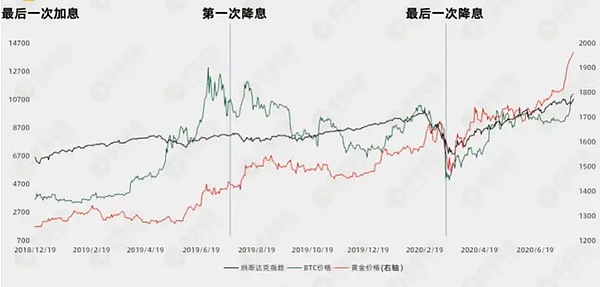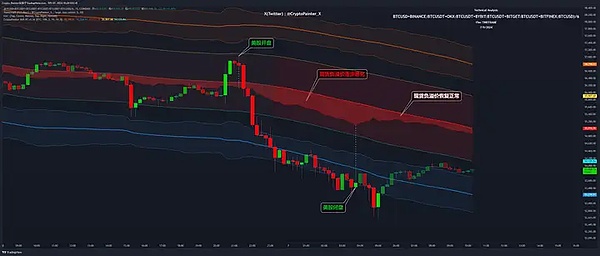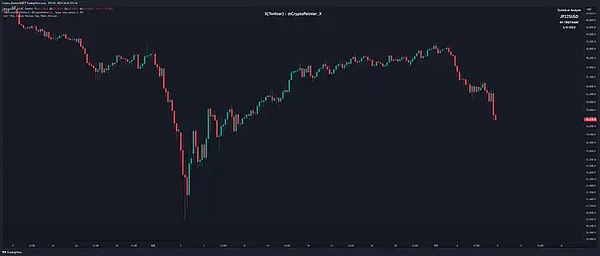Author: Tuanzi Finance
At 20:30 on September 6, the U.S. Department of Labor released non-farm data. The seasonally adjusted non-farm employment in the United States in August was lower than expected. BTC rose accordingly, rising from 55,900 USDT to about 57,000 USDT in a short period of time. However, one hour after the data was released, BTC began to lead the entire crypto market to fall. It fell to 52,550 at the lowest in the early morning and has now rebounded to above 54,000.
Affected by the decline of BTC, the total market value of cryptocurrencies has also fallen sharply. The total market value of cryptocurrencies has now fallen below 2 trillion US dollars
In the past 24 hours, the entire network has blown up $160 million, most of which were long orders, amounting to $124 million. In terms of currencies, BTC liquidated $74.87 million and ETH liquidated $28.62 million.

Looking back at the last rate cut cycle, Bitcoin completed its gains ahead of the rate cut, and began to plummet and decline overall one month before the rate cut. It was not until March 2020 that the liquidity was completely released after the unlimited QE, and the bull market of 2020-2021 was ushered in.
Currently, Bitcoin has also completed a similar advance rise, but the subsequent liquidity improvement is still unknown. The current priority is to stay alive and wait for this moment to come.
The following content comes from Crypto_Painter
Why did the market plummet again after the good news of non-agricultural data?
Looking back at last night's breakout and decline, from the perspective of the spot premium index, we can find that the main selling pressure does come from the spot, and most of it comes from Coinbase! The opening and closing time of the U.S. stock market are marked in the figure. It can be found that the deterioration of the negative premium of the spot market started from the opening time of the U.S. stock market, and gradually returned to normal levels after the closing of the U.S. stock market;

This shows that the main supply of yesterday's decline came from Coinbase's selling at any cost. What exactly caused American investors to suddenly and continuously sell ETFs?
Differences in the expectation guidance of macro data
The current situation is actually somewhat similar to that at the beginning of 2023. The macro background of the former is that no matter what the data is, the expectation is to trade "the end of interest rate hikes" + "interest rate cut cycle". At that time, all bad economic data mean that interest rate cuts will come sooner, and the liquidity tightening environment will ease; that is, "funerals are celebrated as happy events"
However, due to the rebound in unemployment data and the slowdown in economic growth, in the expectations of macro data, the buyer's demand for "trading interest rate cuts" has gradually turned into the seller's supply of "trading recession" or "trading forced interest rate cuts"; The positive impact of bad employment data on the former is far less than the negative impact on the latter, that is, "funerals are celebrated as happy events"
The Japanese yen CarryTrade is once again facing upward pressure on the exchange rate;
![]()

Yesterday, the yen exchange rate once hit the long-term pressure level of 0.007. The market arbitrage funds were full of fear for the breakthrough of this key price, so we can see that the Nikkei 225 fell by nearly 5% in this process;

Combining the above two reasons, we can make a simple inference about the future trend: Will the above situation improve in the future? The answer is simple. The former requires a substantial interest rate cut and liquidity release for a period of time. When the employment data is fully restored and people’s expectations of "trading recession" are dispelled, the market will regain its heat, and this process may take 3 to 6 months;
The latter will be faster. After the arbitrage funds are closed, they will not bring downward pressure to the market. The only uncertainty factor is how much of this part of funds is there? How much is left?
The data given by Morgan is close to 1 trillion US dollars, and more than 50% of the positions have been closed. However, some people think that this data is impossible to estimate because it is difficult to count. The bulk of the yen arbitrage funds actually come from South America, not North America. In other words, the impact on the yen exchange rate is still an unknown;
In any case, when will we see the yen return to a downward trend and when will the crisis be resolved.
 JinseFinance
JinseFinance
 JinseFinance
JinseFinance JinseFinance
JinseFinance ZeZheng
ZeZheng JinseFinance
JinseFinance JinseFinance
JinseFinance JinseFinance
JinseFinance JinseFinance
JinseFinance Brian
Brian Catherine
Catherine nftnow
nftnow